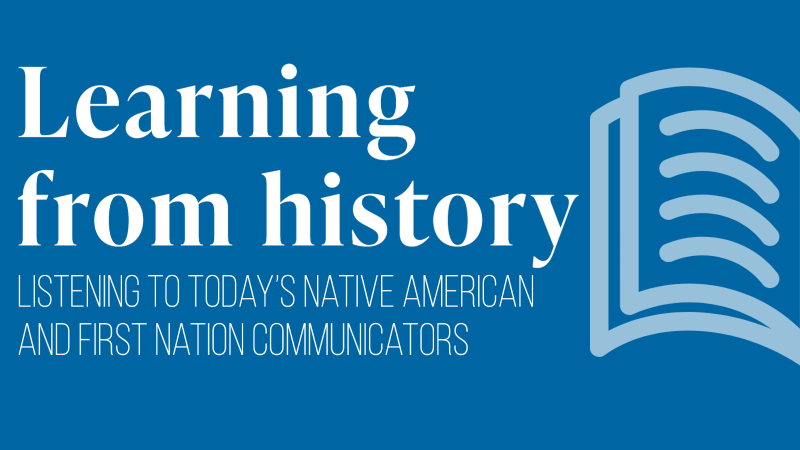Learning from today’s Native American and First Nation communicators
July 8, 2023

By Taylor Voges, Ketchum; Shelley Spector, The Museum of Public Relations; and Yan Jin, University of Georgia
These unfortunate conceptions have led researchers to investigate various portrayals of Indigenous peoples from throughout the U.S. and Canada. Of the studies conducted by researchers on Native Americans, very few put forth Native American and First Nation communicator voices at the center of their work.
To that aim, this joint research by Page/Johnson Legacy Scholars at the University of Georgia and the Museum of Public Relations analyzed Indigenous practitioner panels wherein multiple Native communication professionals spoke to their experiences as Indigenous peoples working in the communications industry in the United States and Canada.
Hallahan’s (1999) public relations framing typology systematically guided our understanding of Indigenous experiences, while Edgett’s (2002) ethical advocacy framework helped illuminate how the communications industry can better support these underserved communities of Indigenous peoples throughout the U.S. and Canada.
The two panels were held over Zoom during November of 2021 and 2022. November was designated by Pres. Bush in 1990 as Native American Heritage Month in the US, while June is the designated month in Canada to honor First Nation peoples. To our knowledge, these programs–focusing specifically on Indigenous communicators– were the first of their kind.
Two panels in each of the two programs comprised of Native American and First Nation communication practitioners, totaling nearly 50 individuals from as many tribes, who spoke about their experiences as Indigenous communicators working in the United States and Canada. The two panels comprised representatives from tribes throughout the US and Canada, with approximately one-third from First Nation tribes in Western Canada. They were employed by agencies, corporations, Native-run casinos, and news services.
The extensive data provided in more than four hours of moderated discussions provided unique insights into the role of Communicators in strengthening relationships between Indigenous tribes and the public at large. Once analyzed, these insights have resulted in actionable strategies that practitioners can apply to their everyday communications work when reaching out to Indigenous audiences.
The ultimate purpose of this research is to provide organizations with fresh new guidance on building relationships with today’s Indigenous communities.
#1 Make Connections
Practitioners need to develop connections with Native Americans and First Nations. Almost every practitioner expressed the need for general communication practitioners to work with Indigenous peoples, with a key distinguishing point between being a “topic” of discussion and co-creating the discussion. Connecting with Native Americans and First Nations is one step that will help assuage the issue. This desire underlines how Native American communicators and peoples have felt distant from North American society. These connections can integrate voices into broader social conventions and lead to indirect implications on social misrepresentations and misunderstandings.
#2 Collect and Share Resources
Practitioners need to both collect and develop resources that allow them to both learn about and fact-check information on Native American and First Nation cultures. Many panelists recounted experiences that required them to redirect non-Indigenous peoples to better source information. While these interactions ultimately resulted in positive promotions of diverse cultures, they indirectly place an undue burden on the tribes. A step in the right direction, for communicators, is to gather educational materials that enhance personal understandings of different peoples.
#3 Another Line of Defense
Practitioners need to stand up when false or incorrect information is shared. Too many Native American and First Nation practitioners expressed their position as a communicator as one that corrects information. They unsurprisingly referenced inaccurate representations and misinformation about Native Americans and First Nations that required them to spend additional time correcting inaccuracies.
This undue burden distracts Native American and First Nation communicators from their main objectives and instead requires them to spend a good portion of their jobs on a task that can, and should, be shared across–not only the communication industry–but society. Becoming another line of defense requires practitioners to act when faced with inaccurate or hurtful information. Essentially, practitioners need to ask themselves “how should I act when faced with information that is false, inaccurate, or hurtful?” We encourage practitioners to reflect and consider the stances they are willing to take when they encounter unfortunate information about Native American and Indigenous peoples.
Looking Forward
These insights from Native American and First Nation practitioners provide one of the first deep learnings of the challenges and opportunities organizations and the society in the United States are facing when it comes to integrity in public communication about and with Native American and First Nation communities.
The actionable ways of effective and ethical communication approaches voiced by Native American and First Nation communication professionals provide a solid base for improving education, training and practice populations, moving from historical representations to hopeful future actions together.
Communicators need to take time to reflect on their personal understandings to identify ways that we can integrate diverse voices into our work. The road is long, and the work will never be over, but these insights offer a strong first step in the right direction and encourage practitioners to remember why they became communicators: to amplify voices.
All quotes cited in this blog post are from the Native American communicators panels held by The Museum of Public Relations.

